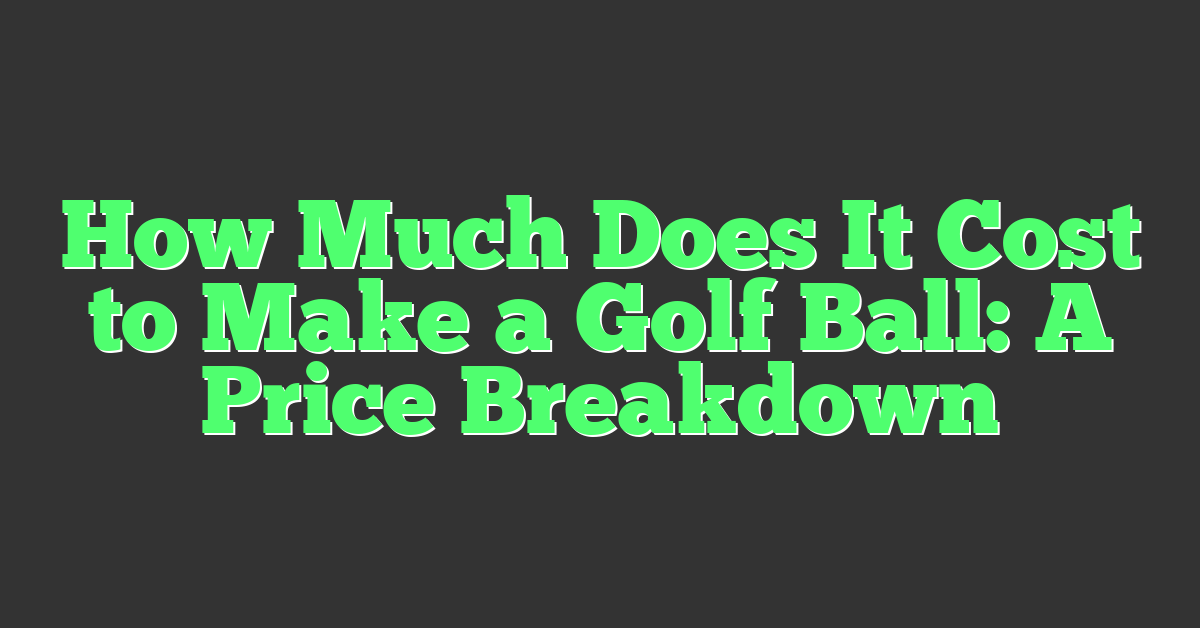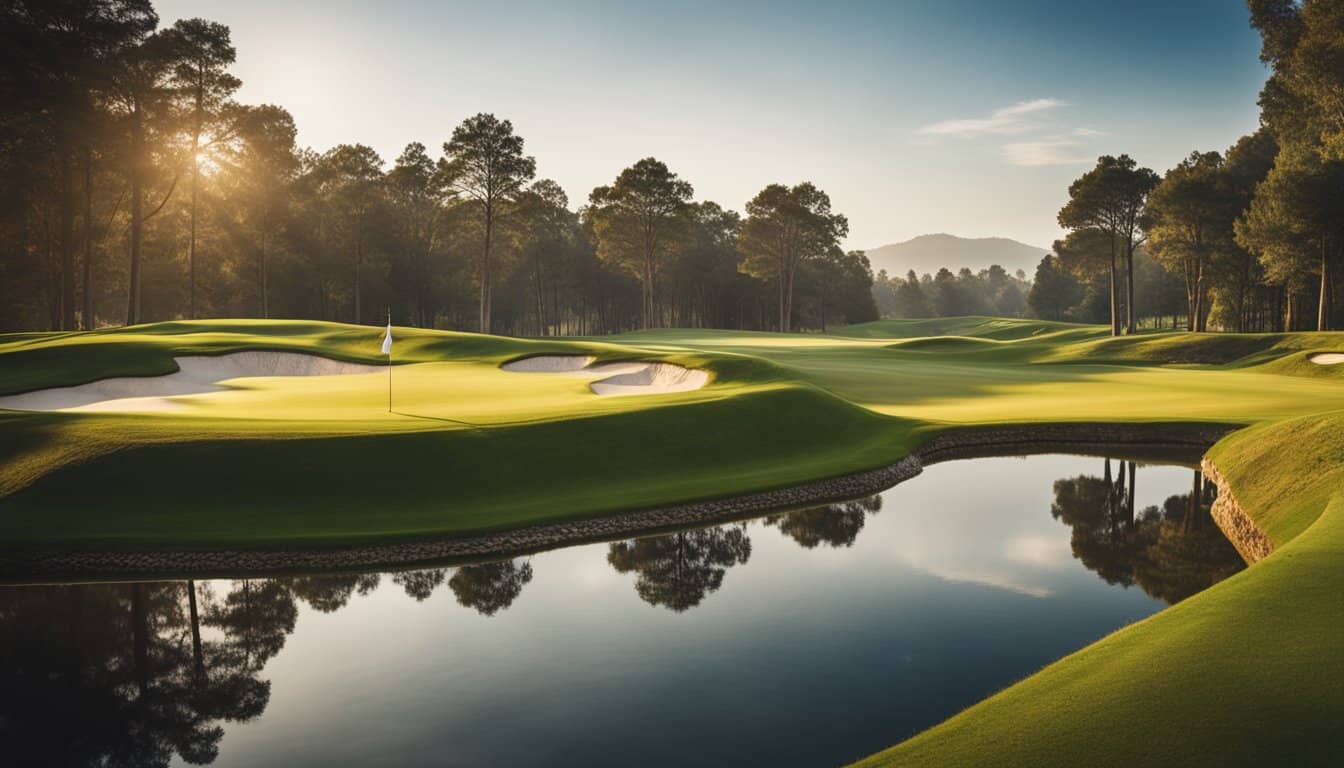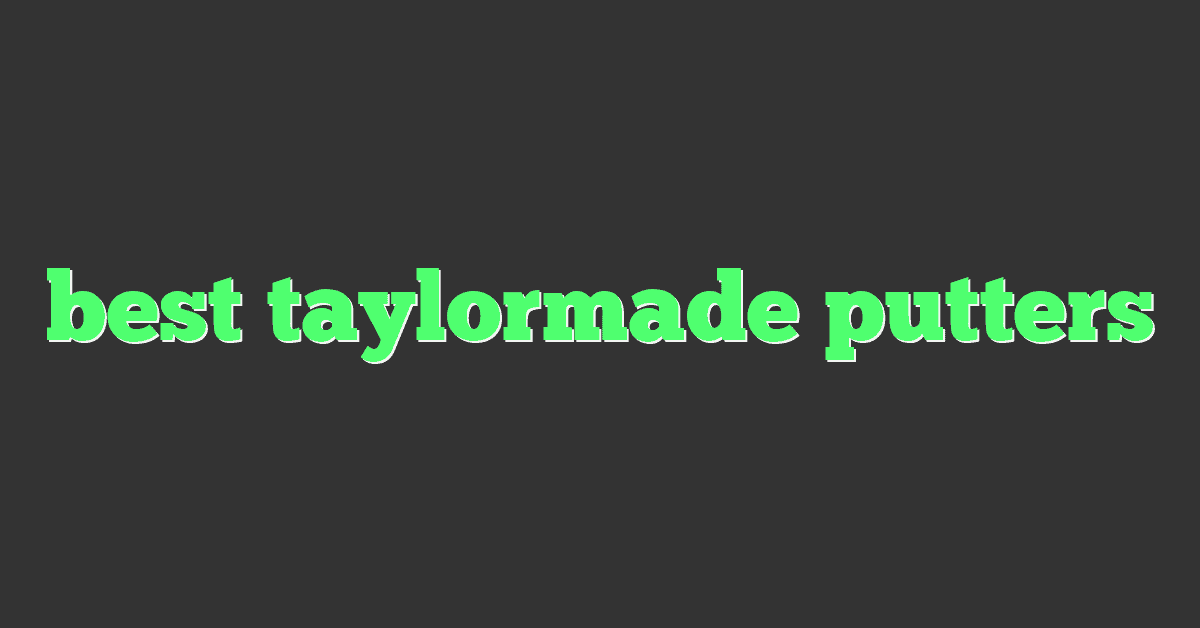If you’re an avid golfer, you probably know that golf balls can be expensive. But have you ever wondered how much it actually costs to make a golf ball? The answer may surprise you.

Golf ball manufacturing involves a complex process that includes designing, testing, and producing the ball. The cost of each ball can vary depending on factors such as the materials used, the manufacturing process, and the branding and marketing involved. While some golf balls can cost as little as a few dollars, others can cost up to $5 or more per ball.
Despite the cost, golf balls remain an essential part of the game. They come in a variety of types and styles, each with unique features and benefits. In this article, we’ll explore the cost of making a golf ball and the factors that influence its price. We’ll also take a closer look at the different types of golf balls available and provide tips for choosing the right ball for your game.
Key Takeaways
- The cost of making a golf ball can vary depending on factors such as materials used, manufacturing process, and branding and marketing.
- Golf balls come in a variety of types and styles, each with unique features and benefits.
- When choosing a golf ball, consider your skill level, playing style, and personal preferences.
History and Evolution of Golf Balls
https://www.youtube.com/watch?v=nPUsF-Xisnw&embed=true
Golf balls have come a long way since their humble beginnings in the 15th century. Originally made from wood, golf balls were small and heavy, and their flight was unpredictable. It wasn’t until the advent of the “feathery” ball in the mid-1800s that golf balls began to resemble the modern designs we use today.
From Feathery to Modern Designs
The feathery ball was made by stuffing wet goose feathers into a leather pouch, which was then sewn together and painted. While these balls had better flight characteristics than their wooden predecessors, they were expensive and time-consuming to make. It wasn’t until the introduction of the gutta-percha ball in the mid-1800s that golf balls became more accessible to the average golfer.
The gutta-percha ball was made from the sap of the Malaysian sapodilla tree and was molded into a sphere shape. These balls were cheaper and easier to make than feathery balls and had better flight characteristics. However, they were still prone to damage and could only be used for a limited number of holes.
Fast forward to the modern era, and golf balls have become highly engineered products, designed to maximize distance, accuracy, and feel. Modern golf balls are made from a variety of materials, including rubber, plastic, and metal. They are designed to be aerodynamically efficient, with dimples on the surface to reduce drag and increase lift.
In terms of cost, golf balls can range from a few dollars to over $50 per dozen. The cost of making a golf ball depends on a variety of factors, including the materials used, the manufacturing process, and the level of technology involved. However, it’s safe to say that the cost of making a golf ball has decreased significantly since the days of the feathery ball.
Understanding Golf Ball Construction
https://www.youtube.com/watch?v=DXHobm5t3Ak&embed=true
When it comes to understanding the cost of a golf ball, it is essential to understand the construction of a golf ball. A typical golf ball has two main components: the core and the cover. The core is the center of the ball, while the cover is the outer layer. The materials used in the construction of both the core and the cover can significantly impact the cost of a golf ball.
Layers and Core Materials
Golf balls can have a one-piece, two-piece, three-piece or multi-layered construction. The most basic construction is the one-piece ball, which is typically made of a solid piece of Surlyn. Two-piece balls have a solid core, usually made of synthetic rubber, and a cover made of Surlyn or ionomer. Three-piece balls have a liquid or solid rubber core, surrounded by a layer of enhanced rubber, and a cover made of Surlyn or urethane. Multi-layered balls have a complex construction, with a soft inner core, a firmer outer core, and a cover made of urethane.
The materials used in the core can also impact the cost of a golf ball. Synthetic rubber is the most common material used in golf ball cores. However, some manufacturers use proprietary materials, such as Titleist’s Polybutadiene core, which is designed to provide a soft feel and low spin.
Cover Technologies
The cover of a golf ball is the outermost layer and can be made of a variety of materials, including Surlyn, urethane, and ionomer. Surlyn is a durable, low-cost material that is commonly used in two-piece balls. Urethane is a premium material that provides a soft feel and high spin, making it a popular choice for tour-level balls. Ionomer is a mid-range material that provides a balance of distance, spin, and durability.
Manufacturers use different cover technologies to enhance the performance of their golf balls. For example, Titleist’s Pro V1 features a cast urethane cover that provides a soft feel and high spin, while Callaway’s Chrome Soft has a dual-core construction that maximizes distance and spin.
In conclusion, understanding the construction of a golf ball is essential in determining its cost. The materials used in the core and cover, as well as the number of layers, can significantly impact the price of a golf ball. When choosing a golf ball, it is essential to consider your skill level, playing style, and budget.
The Manufacturing Process
https://www.youtube.com/watch?v=s4WHZJRu-s4&embed=true
Making a golf ball is a complex process that involves several steps. In this section, we will discuss the production steps and quality control measures involved in making a golf ball.
Production Steps
The first step in the manufacturing process is to create the core of the golf ball. The core is made of a rubber compound that is molded into a sphere. The core is then covered with a layer of rubber to create the inner layer of the ball.
Next, the ball is covered with a layer of plastic or rubber. This layer is designed to provide the ball with its unique characteristics, such as spin, distance, and feel. The outer layer is then painted and stamped with the manufacturer’s logo and other identifying information.

« Is Golf Ball Hunting Illegal? Exploring the Laws and Regulations
How to Make Golf Ball Cake Pops: A Fun and Delicious Treat for Any Golf Fan »
Finally, the golf ball is packaged and sent to retailers for sale.
Quality Control
Quality control is an essential part of the manufacturing process. The golf ball must meet specific standards for weight, size, and performance. To ensure that the ball meets these standards, several quality control measures are in place.
During the manufacturing process, the golf ball is subjected to rigorous testing. The ball is tested for weight, size, and compression. The ball is also tested for its aerodynamic properties, such as spin and trajectory.
In addition to these tests, the golf ball is also tested for its durability. The ball is subjected to a series of impact tests to ensure that it can withstand the rigors of play.
Overall, the manufacturing process for a golf ball is a precise and complex operation that requires a great deal of skill and attention to detail. The quality control measures in place ensure that each ball meets the highest standards of performance and durability.

Cost Factors in Golf Ball Production
https://www.youtube.com/watch?v=Wsz8qWhSwEY&embed=true
When it comes to the cost of making a golf ball, there are several factors that come into play. Understanding these factors can help you better appreciate the cost of your favorite golf ball. In this section, we will discuss some of the major cost factors in golf ball production.
Materials and Labor
One of the biggest cost factors in golf ball production is the materials used to make the ball. Golf balls are typically made of three layers: the core, the mantle, and the cover. The core is usually made of rubber or synthetic rubber. The mantle is made of various materials, including rubber, plastic, and metal. The cover is usually made of a mixture of materials, including plastic, rubber, and urethane.
The cost of these materials can vary widely, depending on factors such as quality, availability, and geographic location. In addition to the cost of materials, labor is also a significant cost factor in golf ball production. The cost of labor can vary depending on the location of the manufacturing facility and the skill level of the workers.
Research and Development
Another major cost factor in golf ball production is research and development. Golf ball manufacturers invest heavily in research and development to create new and innovative products that meet the needs of golfers. This includes developing new materials and manufacturing processes, as well as testing and refining new designs.

The cost of research and development can be significant, and it is often reflected in the price of the final product. However, it is important to note that this investment in research and development is what allows golf ball manufacturers to continue to innovate and improve their products over time.
Economies of Scale
Finally, economies of scale can also play a role in the cost of golf ball production. As production volume increases, the cost per unit of production tends to decrease. This is because fixed costs, such as equipment and facilities, can be spread over a larger number of units.
Golf ball manufacturers often take advantage of economies of scale by producing large quantities of golf balls at once. This can help to reduce the cost per unit of production, which can ultimately result in lower prices for consumers.
In summary, the cost of making a golf ball is influenced by a variety of factors, including the cost of materials and labor, research and development costs, and economies of scale. Understanding these factors can help you better appreciate the cost of your favorite golf ball.
Branding and Marketing Influence
https://www.youtube.com/watch?v=4MPTqFEqGhI&embed=true
When it comes to the cost of making a golf ball, branding and marketing play a significant role in determining the final price. In this section, we will explore how brand value and perception, as well as advertising and sponsorship, impact the cost of producing a golf ball.
Brand Value and Perception
Golf ball brands that are perceived as high-end and premium, such as Titleist and Callaway, can charge a premium price for their products. This is because these brands have established themselves as leaders in the industry and have built a reputation for producing high-quality golf balls that perform well on the course.
On the other hand, lesser-known brands or those that are perceived as lower quality may have to price their products lower to compete with the bigger brands. This is because consumers may be less willing to pay a premium price for a product from a brand they are not familiar with or do not trust.
Advertising and Sponsorship
Marketing and advertising campaigns can also have a significant impact on the cost of making a golf ball. Brands that invest heavily in advertising and sponsorships, such as Titleist and Callaway, may have to charge more for their products to cover the cost of these campaigns.
Additionally, sponsoring professional golfers and events can be a costly endeavor for golf ball brands. However, this type of exposure can also help increase brand awareness and perception, which can lead to increased sales and higher prices.

Overall, branding and marketing are essential factors that influence the cost of making a golf ball. Golf ball brands that are perceived as high-end and invest heavily in advertising and sponsorships may have to charge more for their products to cover these costs. On the other hand, lesser-known brands or those that do not invest as much in marketing may have to price their products lower to compete with the bigger brands.
Pricing Strategies for Different Markets
When it comes to pricing golf balls, there are various strategies that manufacturers use to cater to different markets. Here are some common pricing strategies that golf ball manufacturers use:
Premium vs Value Offerings
Golf ball manufacturers offer a range of products that cater to different skill levels and budgets. Premium offerings are designed for advanced players who demand high performance and are willing to pay a premium price for it. These golf balls are made with the best materials and advanced technology, resulting in superior performance and longer lifespan.
On the other hand, value offerings are designed for beginners and casual players who are looking for an affordable option. These golf balls are made with cheaper materials and may not offer the same level of performance as premium offerings. However, they are still suitable for casual play and practice.
Retail and Bulk Pricing
Golf ball manufacturers also use retail and bulk pricing strategies to cater to different markets. Retail pricing is designed for individual customers who purchase golf balls in small quantities. These customers are willing to pay a premium price for the convenience of buying golf balls in small quantities.

Bulk pricing, on the other hand, is designed for businesses and organizations that purchase golf balls in large quantities. These customers are looking for discounts and are willing to buy in bulk to save money. Golf ball manufacturers offer discounts for bulk purchases, making it an attractive option for businesses and organizations.
In conclusion, pricing strategies for golf balls vary depending on the target market. Manufacturers use different pricing strategies to cater to different skill levels and budgets. Whether you are a beginner or an advanced player, there is a golf ball that suits your needs and budget.
The Role of Golf Ball Performance
When it comes to golf balls, performance is key. The right ball can make a big difference in your game, helping you hit longer drives, make more accurate shots, and even improve your short game. In this section, we’ll take a closer look at how golf ball performance is affected by different factors, including distance, spin, compression, and soft feel.
Distance and Spin
Distance and spin are two of the most important factors when it comes to golf ball performance. A ball that travels farther can help you hit longer drives and reach the green in fewer shots, while a ball with more spin can help you control your shots and stop the ball on the green.
The distance a ball travels is affected by a number of factors, including the ball’s compression, cover material, and dimple pattern. A ball with a high compression rating will generally travel farther than a ball with a lower compression rating, while a ball with a softer cover material may not travel as far but will provide more spin and control.

Spin, on the other hand, is affected by the ball’s cover material and dimple pattern. A ball with a softer cover material will generally provide more spin, while a ball with a more aerodynamic dimple pattern will help the ball spin more consistently and predictably.
Compression and Feel
Compression and feel are two other important factors when it comes to golf ball performance. Compression refers to the amount of force required to compress the ball when it is struck, while feel refers to the ball’s softness or hardness.
A ball with a higher compression rating will generally feel harder and provide more distance, while a ball with a lower compression rating will feel softer and provide more spin and control. The feel of a ball is affected by a number of factors, including the ball’s cover material, compression rating, and overall design.
When choosing a golf ball, it’s important to consider all of these factors and find a ball that is best suited to your individual needs and playing style. By understanding how golf ball performance is affected by different factors, you can make an informed decision and improve your game on the course.
Consumer Choices and Preferences
When it comes to choosing the right golf ball, there are a few things to consider. Your skill level and playing style should be the first things you consider. The type of ball you choose can have a significant impact on your game, and the right ball for you will depend on your individual preferences.
Skill Level and Playing Style
If you’re a beginner or a high handicap player, you may want to consider using a softer ball. These balls are more forgiving and will help you get more distance on your shots. As you improve your game, you may want to switch to a harder ball that offers more control and spin.
If you’re an experienced player, you may want to choose a ball that offers more spin and control. These balls are designed for players who have a more consistent swing and can take advantage of the extra spin.
Selection by Handicap
Your handicap can also play a role in the type of ball you choose. If you have a high handicap, you may want to consider using a ball that is designed for distance. These balls are typically softer and will help you get more distance on your shots.
If you have a low handicap, you may want to choose a ball that offers more control and spin. These balls are designed for players who have a more consistent swing and can take advantage of the extra spin.
Ultimately, the type of ball you choose will depend on your individual preferences. Some players prefer a softer ball, while others prefer a harder ball. It’s important to experiment with different types of balls to find the one that works best for you.

The Market for Used Golf Balls
If you are looking to save money on golf balls, you might want to consider purchasing used golf balls. Used golf balls can be found in a variety of conditions and quality, and can be significantly cheaper than new golf balls.
Condition and Quality
The condition and quality of used golf balls can vary greatly. Some used golf balls may be in excellent condition, while others may have scuffs, scratches, or discoloration. When purchasing used golf balls, it is important to pay attention to the condition and quality of the balls.
Pricing and Availability
Used golf balls can be purchased from a variety of sources, including online marketplaces like eBay. The pricing and availability of used golf balls can vary depending on the condition and quality of the balls, as well as the seller.
When purchasing used golf balls, it is important to compare prices and quality between different sellers. You may be able to find a great deal on used golf balls if you are willing to do some research and shop around.
Overall, purchasing used golf balls can be a great way to save money on your golf game. Just be sure to pay attention to the condition and quality of the balls, and compare prices and availability between different sellers.

Popular Golf Ball Brands and Models
When it comes to golf balls, there are a lot of options available on the market. Some of the most popular brands include Titleist, Callaway, TaylorMade, Wilson, Bridgestone, and Srixon. Each brand offers a variety of models that cater to different player preferences and skill levels.
Titleist Pro V1 and Competitors
One of the most popular golf balls on the market is the Titleist Pro V1. This premium model features a multi-component design and is known for its exceptional distance, spin control, and durability. It is a favorite among professional and amateur golfers alike.
Competing with the Titleist Pro V1 are other premium models such as the TaylorMade TP5 and the Callaway Chrome Soft. These golf balls also feature multi-component designs and are designed to provide exceptional performance.
Specialty and Tour Models
In addition to premium models, many golf ball brands offer specialty and tour models. These golf balls are designed for specific player preferences and skill levels. For example, Titleist offers the AVX model, which is designed for players who want a softer feel and lower ball flight.
TaylorMade offers the P7MB model, which is designed for better players who want a more traditional look and feel. Bridgestone offers the Tour B X model, which is designed for players who want a high level of control and spin.

Overall, there are a lot of golf ball options available on the market. Whether you’re a beginner or a professional, there is a golf ball out there that is perfect for your game.
Tips for Buying Golf Balls
When it comes to buying golf balls, there are a few things to keep in mind to ensure you get the best value for your money. Here are some tips to help you choose the right ball and find the best deals.
Where to Find the Best Deals
If you’re looking to save money on golf balls, start by checking out online retailers. You can often find great deals on golf balls from trusted retailers like Amazon, Dick’s Sporting Goods, and Golf Galaxy. You can also check out the websites of major golf ball manufacturers like Titleist, Callaway, and TaylorMade for special offers and promotions.
Another option is to visit your local pro shop or golf course. Many pro shops offer discounts on golf balls, especially if you buy them in bulk. You can also check out the sales rack at your local golf course for discounted balls that are still in good condition.
Choosing the Right Ball for You
When it comes to choosing the right golf ball for your game, it’s important to consider your skill level and playing style. If you’re a beginner, you may want to start with a softer ball that will give you more distance and forgiveness on mishits. If you’re a more experienced player, you may want to opt for a harder ball that will give you more control and spin.
You should also consider the conditions you typically play in. If you play in wet or windy conditions, you may want to choose a ball with a softer cover that will help you maintain control. If you play in dry conditions, you may want to choose a ball with a harder cover that will give you more distance.
Finally, don’t be afraid to experiment with different types of golf balls to find the one that works best for you. Try out a few different brands and models to see which one gives you the best results on the course.










